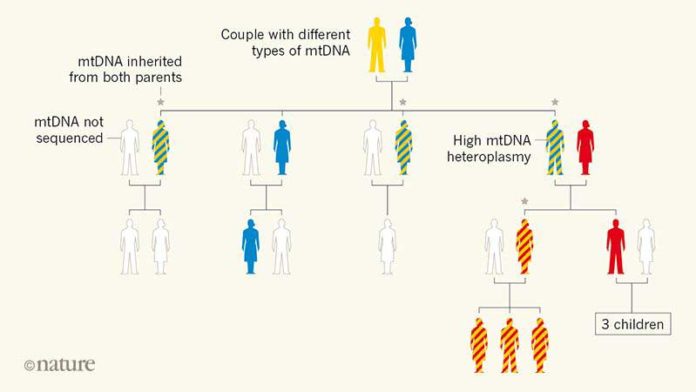DNA, or deoxyribonucleic acid, is the hereditary material in humans and almost all other organisms. Nearly every cell in a person’s body has the same DNA. Most DNA is located in the cell nucleus (where it is called nuclear DNA), but a small amount of DNA can also be found in the mitochondria, where it is called mitochondrial DNA or mtDNA.
The nucleus harbors most of our genes, tightly packaged into 46 chromosomes, of which half are inherited from our mother’s egg and a half from our father’s sperm. By contrast, mitochondrial DNA (mtDNA) was thought to derive exclusively from maternal egg cells, with no paternal contribution.
In a study published in the journal PNAs, Shiyu Luoa, lead authors provided evidence that in rare cases, the father might pass on his mtDNA to the offspring.
Early speculations proposed that fatherly mtDNA molecules ended up weakened in number with respect to maternal mtDNA ones in the fertilized egg, however, these ideas were supplanted when proof from various organisms, for example, the uni-cell alga Chlamydomonas reinhardtii and medaka fish, demonstrated that fatherly mtDNA is quickly disposed of after fertilization.
For quite a long time, analysts have guessed on why healthy organisms forms get their cell powerhouses from only one parent and on the conceivable transformative focal points given by mitochondrial genes acquired in this mold.
During the study, Luo and colleagues identified three families with mtDNA heteroplasmy that could not be explained by maternal inheritance. Scientists performed high-resolution mtDNA sequencing, but did not identify any disease-causing mtDNA mutations.
Their study reveal that high levels of mtDNA heteroplasmy. To further trace the origin of this mysterious mtDNA pattern, scientists extended their investigation to the previous generation.
Sequencing of the mtDNA of the kid’s maternal grandparents uncovered an unexpected contribution: his unusual mtDNA design appeared to be the result of mtDNA from both grandparents. The creators proceeded to distinguish two extra and disconnected families that had a biparental mitochondrial transmission. A comparable situation was recently seen in a person with a mitochondrial illness who had an in a fatherly way acquired mtDNA variant. Together, these reports give proof to biparental mitochondrial legacy in people.
Moreover, the estimated frequency of mutations of matrilineal mtDNA has made it a useful and often-used tool in studies of ancestry and evolution, as well as in forensic identification12. Human mtDNA has also been a valuable tool in archaeology because of its small size (16,569 base pairs) and circular form make it more resistant to degradation than is nuclear DNA.
Luo et al. suggest that mtDNA heteroplasmy is often overlooked in diagnostics when it does not involve a disease-causing variant. Although this might be true to some extent, it is a rather unsatisfactory explanation in this era of deep DNA sequencing.
Though, the findings should provoke a re-assessment of the extensive global mtDNA sequencing data available, for those wishing to unearth further instances of atypical heteroplasmy.
Although biparental inheritance of mtDNA and heteroplasmy coincided with disease symptoms in some of the individuals studied by Luo et al., the authors’ data do not demonstrate a causal link with disease.
Further study is needed to identify more cases of potential paternal mtDNA inheritance, and to determine the functional consequences of such heteroplasmy.
The findings affect the counseling of individuals carrying disease-causing mtDNA mutations who are considering having children? Not greatly, because paternal mitochondrial transmission seems to be exceedingly rare in humans. At present, this discovery represents an interesting conceptual breakthrough, rather than one that will directly influence clinical practice.
